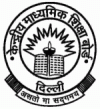
Courses of Studies 2011
Class : 11th & 12th
2. ENGLISH CORE (Code No. 301)
Background
Students are expected to have acquired a reasonable degree of language
proficiency in English by the time they come to class XI, and the course will
aim, essentially, at promoting the higher-order language skills.
For a large number of students, the higher secondary stage will be a preparation
for the university, where a fairly high degree of proficiency in English may be
required. But for another large group, the higher secondary stage may be a
preparation for entry into the world of work. The Core Course
should cater to both groups by promoting the language skills required for
academic study as well as the language skills required for the workplace.
Objectives
The general objectives at this stage are:
to listen to and comprehend live as well as recorded oral presentations on a
variety of topics,
to develop greater confidence and proficiency in the use of language skills
necessary for social and academic purposes.
to participate in group discussions/interviews, making short oral presentations
on given topics.
to perceive the overall meaning and organisation of the text (i.e., the
relationships of the different “chunks” in the text to each other).
to identify the central/main point and supporting details, etc.
to build communicative competence in various registers of English.
to promote advanced language skills with an aim to develop the skills of
reasoning, drawing inferences, etc. through meaningful activities.
to translate texts from mother tongue (s) into english and vice versa.
to develop ability and knowledge required in order to engage in independent ~
reflection and enquiry.
to develop the capacity to appreciate literary use of English and also use
English creatively and imaginatively.
At the end of this stage learners will be able to do the following:
read and comprehend extended texts ( prescribed and non-prescribed) in the
following genres: fiction, science fiction, drama, poetry, biography,
autobiography, travel and sports literature, etc.
text-based writing (i.e., writing in response to questions or tasks based on
prescribed or unseen texts)
understand and respond to lectures, speeches, etc.
write expository/argumentative essays of 250-500 words, explaining or
developing a topic, arguing a case, etc.
write formal/informal letters and applications for different purposes.
write items related to the workplace (minutes, memoranda, notices, summaries
reports; filling up of forms, preparing CVs, e-mail messages, etc.).
taking/making notes from reference materials, recorded talks etc.
Language Items
The Core Course should draw upon the language items suggested for
classes IX-X and delve deeper into their usage and functions. Particular
attention may, however, be given to the following areas of grammar:
the uses of different tense forms for different kinds of narration (e.g. media
commentaries, reports, programmes, etc.).
the use of passive forms in scientific and innovative writings
converting one kind of sentence/clause into a different kind of structure as
well as other items to exemplify stylistic variations in different discourses
modal auxiliaries – uses based on semantic considerations.
Methods and Techniques
The techniques used for teaching should promote habits of self-learning and
reduce dependence on the teacher. In general, we recommend a multi-skill,
learner-centred, activity based approach, of which there can be many variations.
The core classroom activity is likely to be that of silent reading of
prescribed/selected texts for comprehension, which can lead to other forms of
language learning activities such as role play, dramatization, group discussion,
writing, etc. although many such activities could be carried out without the
preliminary use of textual material. It is important that students be trained to
read independently and intelligently, interacting actively with texts, with the
use of reference materials (dictionaries, thesauruses, etc.) where necessary.
Some pre-reading activity will generally be required, and the course books
should suggest suitable activities, leaving teachers free to devise other
activities when desired. So also, the reading of texts should be followed by
post reading activities. It is important to remember that